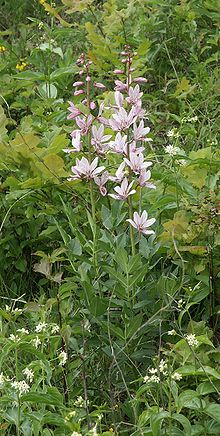- Dictamnus
-
Dictamnus 
Dictamnus albus in flower Scientific classification Kingdom: Plantae (unranked): Angiosperms (unranked): Eudicots (unranked): Rosids Order: Sapindales Family: Rutaceae Genus: Dictamnus Species: D. albus Binomial name Dictamnus albus
L.Synonyms - Dictamnus fraxinella Pers. [1]
Dictamnus is a genus of flowering plant in the family Rutaceae, with a single species, Dictamnus albus. It is known variously as Burning-bush, False Dittany, White Dittany, Gas-plant and Fraxinella. It is a perennial herb, native to southern Europe, north Africa and throughout Asia.
Contents
Description
This plant grows about 60 cm high. Its flowers form a loose pyramidal spike and vary in colour from pale purple to white. It normally grows in woods in warm places. It is a popular garden plant both for its flowers and for its fragrance. It bears large elegant flowers of various colours: red, white, striped or blue. Its leaves resemble those of an Ash tree. Outside its natural range it is planted in gardens and grows well in warm places. It can also be found in sheltered places in woodlands.
In the summer months, the whole plant is covered with a kind of flammable substance, which is gluey to the touch, and has a very fragrant smell; but if it takes fire, it goes off with a flash all over the plant.
The name "Burning-bush" derives from the volatile oils produced by the plant, which can catch fire readily in hot weather, leading to comparisons with the burning bush of the Bible, including the suggestion that this is the plant involved there.
Characteristics
- The plant is inedible: the leaves have a bitter and unpalatable taste. Despite the lemon-like smell, the plant is acrid when eaten.
- The plant is more commonly known today as the Burning Bush. It is the essential oil, which has a lemon-like smell, that is flammable. The daughter of Swedish botanist Carl Linnaeus is said to have ignited the air once, at the end of a particularly hot, windless summer day, above Dictamnus plants, using a simple matchstick.
Historical medical uses
Some use has been made of the plant (chiefly the powdered root) in herbalism. However, as the alternative name "False Dittany" implies, it is unrelated to the Dittany found in Crete, which has a much more significant history of medicinal use. Like Dittany of Crete, Dictamnus was believed to be useful for cordial and cephalic ailments, to help resist poison and combat putrefaction, and to be useful in malignant and pestilential fevers. It was also used for cases of hysteria. While the volatile oil does have anti-inflammatory properties, it is not used for such ailments today.
An infusion of the tops of the plant was also used as a pleasant and efficacious medicine in the gravel. It was believed to work powerfully by provoking urine and easing colicky pains which frequently accompany that disorder. The root was considered a sure remedy for epilepsies, and other diseases of the head, opening obstructions of the womb and procuring the discharges of the uterus. The plant is known to have emmenagogue properties, but the use of such plants to procure the onset of menses is generally considered obsolete today.
Chemistry
More than 100 chemical constituents have been isolated from the genus Dictamnus, including alkaloids, limonoid triterpenoids, flavonoids,sesquiterpenoids, coumarins, and phenylpropane.[2]
Gallery
External links
- ^ Synonym in Anthos.es
- ^ Gao X., Zhao P.-H., Hu J.-F.,"Chemical constituents of plants from the genus Dictamnus". Chemistry and Biodiversity. 8 (7) (pp 1234-1244), 2011. Date of Publication: July 2011. [Journal: Review]
Categories:- Rutaceae
- Flora of Africa
- Flora of Europe
- Medicinal plants
- Monotypic plant genera
- Flora of Asia
Wikimedia Foundation. 2010.






